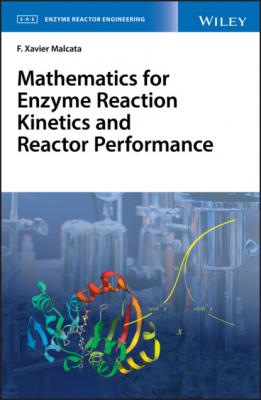Mathematics for Enzyme Reaction Kinetics and Reactor Performance. F. Xavier Malcata
Читать онлайн.| Название | Mathematics for Enzyme Reaction Kinetics and Reactor Performance |
|---|---|
| Автор произведения | F. Xavier Malcata |
| Жанр | Химия |
| Серия | |
| Издательство | Химия |
| Год выпуска | 0 |
| isbn | 9781119490333 |
– so ordered addition of Eqs. (1.1) and (1.11) produces simply
after having x1 factored out; upon multiplication of both sides by a2,2, Eq.,(1.12) becomes
(1.13)
with isolation of x1 unfolding
– a result compatible with Eq. (1.7), once the two fractions are lumped, a1,2 a2,1 b1 canceled out with its negative afterward, and a1,1 finally dropped from numerator and denominator. Recalling Eq. (1.10), one may redo Eq. (1.14) to
(1.15)
as long as
is put forward; all forms conveyed by Eqs. (1.9), (1.10), and (1.16) do indeed share the form
irrespective of the values taken individually by α1,1, α1,2, α2,1, and α2,2. This is why the concept of determinant was devised – representing a scalar, bearing the unique property that its calculation resorts to subtraction of the product of elements in the secondary diagonal from the product of elements in the main diagonal of the accompanying (2 × 2) matrix. In the case of Eq. (1.10), the representation
(1.18)
then the concept of determinant can be extended in very much the same way to produce
(1.19)
however, the mode of calculation of higher order determinants is more complex – as it requires previous conversion to p!/2 second‐order determinants (as will be explained in due course), with calculation of each one to follow Eq. (1.17).
2 Function Features
If a relationship between two real variables, y and x, is such that y becomes determined whenever x is given, then y is said to be a univariate (real‐valued) function of (real‐variable) x; this is usually denoted as y ≡ y{x}, where x is termed independent variable and y is termed dependent variable. The same value of y may be obtained for more than one value of x, but no more than one value of y is allowed for each value of x. If more than one independent variable exist, say, x1, x2, …, xn, then a multivariate function arises, y ≡ y{x1, x2, …, xn , }. The range of values of x for which y is defined constitutes its interval of definition, and a function may be represented either by an (explicit or implicit) analytical expression relating y to x (preferred), or instead by its plot on a plane (useful and comprehensive, except when x grows unbounded) – whereas selected values of said function may, for convenience, be listed in tabular form.
Among the most useful quantitative relationships, polynomial functions stand up – of the form Pn {x} ≡ an xn + an − 1 xn − 1 + ⋯ + a1 x + a0, where a0, a1, …, an−1, and an denote (constant) real coefficients and n denotes an integer number; a rational function appears as the ratio of two such polynomials, Pn {x}/Qm {x}, where subscripts n and m denote polynomial degree of numerator and denominator, respectively. Any function y{x} satisfying P{x}ym + Q{x}ym−1 + ⋯ + U{x}y + V{x} = 0, with m denoting an integer, is said to be algebraic; functions that cannot be defined in terms of a finite number of said polynomials, say, P{x}, Q{x}, …, U{x}, V{x}, are termed transcendental – as is the case of exponential and logarithmic functions, as well as trigonometric functions.
A function f is said to be even when f{−x} = f{x} and odd if f{−x} = −f{x}; the vertical axis in a Cartesian system serves as axis of symmetry for the plot of the former, whereas the origin of coordinates serves as center of symmetry for the plot of the latter. Any function may be written as the sum of an even with an odd function; in fact,
upon splitting f{x} in half, adding and subtracting f{−x}/2, and algebraically rearranging afterward. Note that f{x} + f{−x} remains unaltered when the sign of x is changed, while f{x} − f{−x} reverses sign when x is replaced by −x; therefore, (f{x} + f{−x})/2 is an even function, while (f{x} − f{−x})/2 is an odd function.
When the value of a function repeats itself at regular intervals that are multiples of some Τ, i.e. f{x + nΤ} = f{x} with n integer, then such a function is termed periodic of period Τ; a common example is sine and cosine with period 2π rad, as well as tangent with period π rad (as will be seen below).
